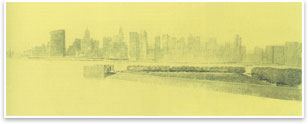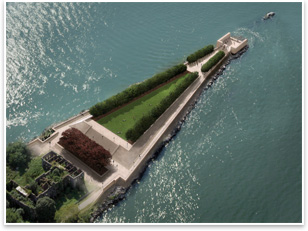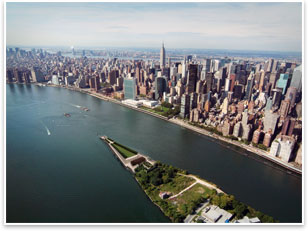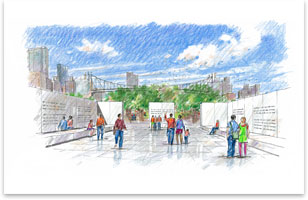
| Its Quiet Optimism Maintained, Louis Kahn’s Roosevelt Island FDR Memorial Moves into Construction After 35 years, Mitchell/Giurgola sees Kahn’s vision into fruition Summary: Twice aborted due to financial constraints, the Franklin Delano Roosevelt Memorial designed by 1971 AIA Gold Medal Recipient Louis Kahn will finally begin to take shape on an island named after the 32nd president on the East River between Manhattan and Queens. Last month, the Roosevelt Island Operating Corporation (RIOC) approved the plan with Mitchell/Giurgola Architects as design caretakers. 
An original sketch of Four Freedoms Park by Louis Kahn. Image courtesy of 1973 Louis I Collection, University of Pennsylvania and the Pennsylvania Historical and Museum Commission. What will be Kahn’s first-ever project in New York City began in the in the early 1970s and ended abruptly with the city’s precipitous brush with bankruptcy in 1975. It gained momentum again in the 90s, but a lack of state-level political support derailed the project again. Last month, the Roosevelt Island Operating Corporation (RIOC) approved the plan with Mitchell/Giurgola Architects as design caretakers, setting the stage for a strange but sweet irony. In the midst of the greatest economic calamity since the Great Depression, which FDR shepherded the nation through, and after decades of budget-induced disappointment, the 4.5-acre Four Freedoms Park will be realized. Kahn’s simple, triangular sliver of a park will be at the southern tip of Roosevelt Island, named after the president in 1974, two years after Kahn was commissioned for the job. The monument’s site was designated as part of Roosevelt Island’s mid-‘70s development. Kahn (who had worked on Depression-era housing projects in Philadelphia early in his career through Roosevelt-created jobs program, according to Architectural Record) died in 1974, and the office disintegrated with no strong design leader to take command, says Paul Broches, FAIA, a partner at Mitchell/Giurgola, the firm overseeing Kahn’s posthumous project. To see the design realized, Kahn’s Philadelphia-based colleagues needed a local architect in New York, and AIA 1981 Gold Medal Recipient Romaldo Giurgola’s firm emerged as an apt partner. Kahn and Giurgola had taught together at the University of Pennsylvania and were part of an emerging salon of architectural thinkers in Philadelphia that included Robert Venturi, FAIA. Two architects from Kahn’s office joined with Giurgola to form a joint venture to finish the design, but even then there was little to do but plant the project in the ground. By 1975, when New York City nearly went bankrupt and the plan was scuttled, the memorial was largely ready for construction. “Very few blanks needed to be filled in,” says Broches. The project was nearly revived in the mid 1990s when RIOC began a master planning initiative for the entire island including its southern end (a 13-acre parcel called Southpoint) and the memorial site. The memorial site was graded and crafted to prepare for installation, but after George Pataki became governor in 1995, he eliminated Roosevelt Island’s state funding, setting the memorial back again. Interest in the project was renewed when Eliot Spitzer was elected to the statehouse, and the past several years have seen the project’s fortunes (and political support) rise. Construction is slated to begin late this summer. 
Four Freedoms Park. Image courtesy of Franklin D. Roosevelt Four Freedoms Park, LLC. Computer rendering, Chris Shelley. Base photograph, Amiaga Photographers, Inc. Toward freedom The monument begins with a stand of copper beach trees between the woodsy parkland of Southpoint and the landscaped park to the south. The low branches on these trees will block views, revealing the memorial subtly and slowly as visitors walk around them. From here, patrons will have a choice on how they walk to the park’s culmination at the tip of the island. Up a 12-foot grand staircase, the memorial lawn has narrowing green space surrounded by trees. There are also wide waterfront promenades running along the east and west sides of the memorial. Broches thinks these spaces will fulfill a unique need. “There are very few places in the city where you have that immediate connection to the water,” he says. 
Four Freedoms Park features views to the Manhattan skyline and the United Nations Headquarters. Image courtesy of Franklin D. Roosevelt Four Freedoms Park, LLC. Computer rendering, Chris Shelley. Base photograph, Amiaga Photographers, Inc. Visitors who walk along the lawn past a row of trees on each side will experience the progressive, triangular narrowing of the memorial. This leads to an open forecourt and then to another set of narrowing tree rows. (Mitchell/Giurgola is maintaining Kahn’s landscape choices for the memorial, using little leaf linden trees and copper beaches. They are also using the same granite Kahn specified throughout, which is white and flecked with black and gray.) A sculpture court then contains a bust of FDR (the only figurative element in the entire design) molded by Jo Davidson in the 1930s and set in a granite block. Finally, visitors enter “The Room,” a semi-enclosed square section with granite walls that is open to the south. On these granite walls are inscribed passages from FDR’s 1941 “Four Freedoms” speech, which outlined the rights of 20th century humanity: freedom of speech, religion, and from want and fear. This section is the symbolic heart of the $40 million memorial: a meditative and contemplative space; somewhere to be “without an itinerary,” says Broches. The final vista on this design’s narrow circulation path is down a ramp to a waterfront overlook, where the land of Roosevelt Island drops away. From here, visitors have views to the Manhattan skyline and, most appropriately, to the Modernist icon United Nations Building, designed by Wallace Harrison, Oscar Niemeyer, and Le Corbusier—conceived during FDR’s presidency and realized after his death and the global calamity of WWII. Gina Pollara, executive director of the project for Mitchell/Giurgola’s client, The Franklin and Eleanor Roosevelt Institute, calls this building and the views to it from Four Freedoms Park the “physical legacy” of FDR’s presidential tenure. “Many people consider Roosevelt to be the architect of the United Nations,” she says. 
The granite walls that make up “The Room” have passages from FDR’s Four Freedoms speech inscribed on them. Images courtesy of Franklin D. Roosevelt Four Freedoms Park, LLC. Sketch by John Kurtz, Mitchell/Giurgola Architects. Willed forward As people take the journey presented by Kahn’s design, they experience alternating levels of openness and enclosure—confronted with a towering stair, shaded by trees, exposed to the city, walled in by granite—until the monument explodes into ultimate openness with waterfront views of the Manhattan horizon. These changes in enclosure allude to an intermittent loss of perspective and contextual grounding in the world. This idea surely weighed heavily on Roosevelt as he confronted autocratic regimes that had turned inward, wary from a nascent cooperative society of free nations, and extrapolated their darkness to the rest of the globe with violence and oppression. 
A southward view along the triangular, narrowing park. Images courtesy of Franklin D. Roosevelt Four Freedoms Park, LLC. Sketch by John Kurtz, Mitchell/Giurgola Architects. As visitors are willed forward by the site’s geometry, they continually gain perspective on their immediate urban context, lose it, and gain it back again—eventually coming to the words of FDR’s Four Freedoms speech. In these words, installed at the final destination of the memorial, is an idealized vision of humanity in a rational state of nature and empathy. This upward, ennobling trajectory trough of isolation and uncertainty makes a clear case for FDR’s (and perhaps Kahn’s) optimistic faith in the ability of people to perfect their own sense of freedom and universal rights. “The Room’s” conceptual design began with FDR’s belief that any problem can be solved by getting all parties together in a room to discuss common goals, like the realization of each of the four freedoms. This is a philosophy shared by the United Nations Headquarters building just across the East River. The New York FDR memorial will provide a far different experience from Lawrence Halprin’s Washington, D.C., FDR monument on the National Mall. The quiet, abstraction of Kahn’s design harkens back to Maya Lin’s Vietnam War Memorial, which it predates. The New York memorial was designed before the burdens of narrative began creeping into social and political monuments. The Washington memorial, however, explicitly tells a story. It focuses on FDR’s life and times through four outdoor semi-enclosed rooms with text and many figurative sculptures: scenes from the Great Depression and the president’s fireside chats. With its optimistic hope for rational compromise and foregrounding of community perspective, Kahn’s design is less about the legacy of FDR and more about the legacy of his vision of the world. “I remember having taken my children [to the Washington memorial] at various ages, and even when they were very little they learned a lot about Roosevelt,” says Broches. “That clearly would not happen at [Kahn’s memorial]. On the other hand, I think that here, once you have taken this procession and you arrive at The Room, everyone learns something from that too.” |
||
Copyright 2009 The American Institute of Architects. All rights reserved. Home Page |
||
home
news headlines
practice
business
design
recent related
› Gehry Selected to Design Eisenhower National Memorial
› Three Finalists Chosen for Burnham Memorial Design Competition
› At Gonzalez Goodale’s Wilshire Public Park, a Monument to a Dead Hero and Living Activism
Donate to the Four Freedom’s Park.
See what the Public Architects Committee is up to.

